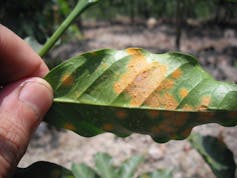The global food system contributes to climate change through industrial farming practices, the increasing use of fertiliser to fight dropping yields and the transport of food around the world. But the fact that climate change has a significant impact on the livelihood of small farmers in the tropics often goes unnoticed.
Climate change has been compounding the economic problems coffee farmers have been experiencing the world over. For these farmers, climate change has meant losses to their crops from either too much rain or due to droughts. Over the past decade, there has been a long-term impact on coffee yields. The livelihoods of small coffee farmers have been especially affected.
Arabica beans, which have an ideal growth temperature of between 18°C and 22°C, currently account for 73% of the coffee grown in Brazil. Studies indicate that a 1°C rise in temperature would result in a loss of 25% of Brazil’s Arabica coffee production. It would also limit coffee production to only 28 municipalities – all in the state of Minas Gerais, Brazil’s principal coffee producing state – down from the current production in 702 municipalities.
Coffee rust
Another impact of climate change on the coffee industry is the Hemileia Vastatrix fungus known as “La Roya” (Spanish for rust), which thrives in warmer temperatures. This rust disease is a fungus that attacks the leaves of the coffee bush, causing the coffee beans to fall off before they reach full maturity, if not leading to poorer bean quality and making coffee plants more susceptible to other diseases.
The rust outbreak in Central America is the worst in about thirty years and losses during the 2013-14 season are expected to be worse than the 20% of the high quality Arabica crop lost during the 2012-13 season.

In the case of Guatemala the outbreak of the fungus has already affected 200,000 producers during the 2013-14 season, double the number of producers affected in 2012-13. In Nicaragua, the rust has meant a reduction of coffee yields by 60%.
The most significant impact of the rust has been in Colombia where the 2011-12 coffee harvest, was its worst in three decades, falling from more than 11 million sacks to under eight million (each sack is 60kg of green beans). This hit the half a million small producer families to a greater extent with coffee prices falling by over 30%. Colombia is not alone in the reduction in yield per hectare and is joined by India, Indonesia and Mexico in having a fall in coffee yield during this period.
The rust crisis is also affecting global coffee prices, probably influencing the decision of the ICE New York futures exchange to add Brazilian origin Arabica to the mix of coffee from 19 countries used to determine the price of Arabica coffee. The harvest in Brazil affects the international coffee price, especially since the drop in prices in 2013 was seen to be based on the back of bumper harvests in Brazil.
Cutting losses
To mitigate the losses from warmer temperatures, large coffee producers are moving to higher altitudes and expanding coffee to new growing areas in Brazil. They are also trying to increase the use of irrigation which is a challenge due to the lack of water.
There are ways to mitigate against the rust disease too. In areas that are severely hit, farmers must start from scratch by planting new coffee trees. Fungicide can contain the spread of the rust and rust resistant trees have been developed in Colombia. The Colombian Coffee Federation has invested in replanting extensively using these rust resistant trees and plans to have about 80-90% of its coffee replanted by 2016.
Unfortunately the choices available to the large producer are not available to small family farmers who are more vulnerable and lack the finances or know-how to move or adapt themselves. But one attempt to help small farmers respond to the threat of climate change is the Coffee and Climate initiative, which brings together examples of best practice as well as information on scientific discoveries.
As well as making global efforts to stem emission-causing global warming, research indicates that agroforestry can be used to mitigate against climate change and help diversify the incomes of the small coffee producers. This is something we have also seen first-hand. These kinds of measures must be replicated around the world to urgently aid farmers in the tropics suffering from the effects of climate change.

